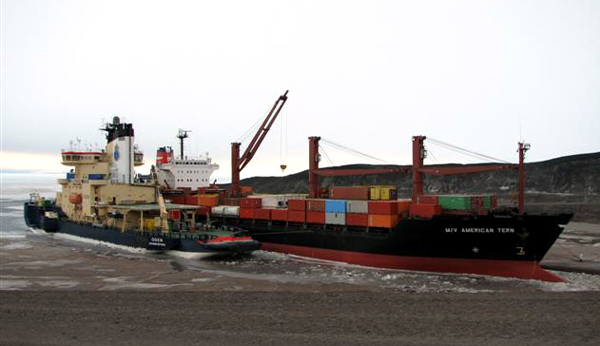
Photo Credit: Chris Demarest/Antarctic Photo Library |
The Swedish icebreaker Oden, left, and the cargo ship American Tern at the McMurdo Station ice pier on Feb. 11, 2008. The NSF has proposed funding for science activities aboard the Oden next season. |
NSF seeks $6.85 billion for FY09
Office of Polar Programs proposes millions for infrastructure and facilities
By Peter Rejcek, Antarctic Sun Editor
Posted February 22, 2008
The National Science Foundation (NSF) is looking to boost its 2009 fiscal year (FY) budget by about 13 percent over the current budget year, with a request for $6.85 billion. The additional $822.1 million would increase funding for agency programs that advance the frontiers of research and education in science and engineering, according to a press release from the foundation.
The total budget request for the Office of Polar Programs (OPP) is a shade over $490 million, an 11 percent increase over OPP’s estimated FY 2008 budget.
A substantial portion of that money, about $30 million, is earmarked for facilities and infrastructure, with $22.66 million pooled for resupply activities for the U.S. Antarctic Program. “Significant funding above the FY 2008 appropriation is essential to diversify and improve the resupply capability to support McMurdo Station, and to ensure the continuity of pier-side cargo and personnel embarkation and debarkation at Palmer Station,” according to the FY09 budget report.
Investments include initiation of contracts to replace the Palmer Station Pier ($8 million), continuing construction of additional fuel storage capacity at McMurdo Station ($4 million), initial procurement of a second heavy traverse for resupply of South Pole Station ($2 million), and consolidation of the McMurdo area runways into a single operational site at the Pegasus Airfield ($2.5 million).
Another $5.39 million would be available to offset mainly fuel costs associated with military aircraft and re-supply and research vessel operations. The NSF hopes to save about $3 million next fiscal year by discontinuing support for maintaining the U.S. Coast Guard’s Polar Star in caretaker status.
Coming in at $255 million, Antarctic infrastructure and logistics support accounts for more than half of OPP’s entire budget. The NSF has also proposed more than $71 million for Antarctic research, an 18 percent increase over the current fiscal year. About 40 percent is for new research grants, while the remainder will fund ongoing studies.
Proposed science highlights include:
- Remote Sensing Instrumentation — an increase of $5.41 million to support development of instrumentation and equipment required for critical observations in all areas of Antarctic science.
- IceCube Neutrino Observatory — an increase of $3.44 million to enable early science operations ($650,000) for the part of the detector array that has been completed (25 of 70 detector strings) and research ($2.79 million) to exploit data returned from the growing array.
- International Polar Year (IPY) — an increase of $1.69 million to support IPY synthesis activities that will bring together U.S. researchers, the international science community, and students to advance understanding of the Antarctic system in a global context, as well as to promote understanding of biotic systems during time of change.
- Oden Science — an increase of $350,000 to support collaboration with Swedish scientists for research related to oceanography in the Southern Ocean aboard the Swedish research and icebreaker vessel.
NSF Director Arden L. Bement Jr. said the agency’s overall budget increases reflected a growing consensus that the United States needs to invest more resources in basic scientific research if it is to remain a global leader in science and technology.
“More than a dozen major studies have now concluded that a substantial increase in federal funding for basic scientific research is critical to ensure the preeminence of America’s scientific and technological enterprise,” Bement said.
“Increased federal investments in research and education are imperative now to sustain our comparative advantages in a flattening world,” he added. “The NSF budget for 2009 reflects that commitment.”
NSF is funded at $6.065 billion for the 2008 fiscal year that began on Oct.1, 2007, and ends on Sept. 30, 2008. The funds are provided in the $473.5-billion Consolidated Appropriations Act of 2008 (H.R. 2764). The measure consolidates 11 of the 12 regular appropriations bills that fund the federal government each year. (In November, Congress passed and President Bush signed into law the FY 2008 Department of Defense appropriations bill.)
NSF funds reach all 50 states through grants to more than 1,700 universities and institutions. Each year, NSF receives about 42,000 competitive requests for funding, and makes more than 10,000 new funding awards. The NSF also awards more than $400 million in professional and service contracts yearly.





